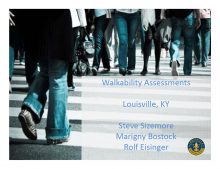We are pleased to announce an exciting new alliance between Active Living Research and GP RED to co-host and coordinate...
Taking Research to Action through Neighborhood Walkability Assessments

Presentation at the 2011 Active Living Research Annual Conference
Background:
Walking is our oldest and most basic form of transportation - one that is essential not only to our individual health, but also to the overall livability of our cities. Modernization for many cities has meant replacing walking with motorized travel as a primary form of transportation. Louisville is a leading site for Healthy Kids, Healthy Communities (HKHC), a national program of the Robert Wood Johnson Foundation (RWJF) whose primary goal is to implement healthy eating and active living policy- and environmental-change initiatives that support healthier communities for children and families.
In Louisville, the HKHC initiative is focused in 12 lower income neighborhoods and is a part of the Mayor’s Healthy Hometown Movement (MHHM), which began in 2004. Led by the Louisville Metro Department of Public Health and Wellness (LMPHW), MHHM unites diverse community partners from business, schools, government, academia, neighborhood groups and non-profit organizations to coordinate activities that will increase physical activity and healthy eating to improve the health of Louisville Metro residents.
Active living is a major focus of MHHM through its Step Up, Louisville committee. MHHM partners from Planning & Design Services, the Department of Public Health & Wellness, Public Works and Assets and the University of Louisville have worked together to create, validate and implement Louisville’s walkability assessment tool. During this four year process the goal has been to increase walkability in Louisville neighborhoods through a participatory process including city officials, trained volunteers and neighborhood residents, with an emphasis on youth engagement. Residents play a key role in reviewing the final walkability assessment reports, which they present to local policy makers such as Metro Council members and other city officials in order to address neighborhood improvements.
Objectives:
As part of HKHC, the objectives of the walkability assessments are to:
1. By November 7th, 2010, assess walking conditions in HKHC neighborhoods, including streetscapes, sidewalks, lighting, vacant lots, and abandoned houses.
2. By November 18, 2010, present walkability assessment reports to policy makers.
3. By December 17th, 2010, complete improvements in at least two of the 12 neighborhoods through the use of the walkability assessment process.
4. By January 21st, 2011, integrate assessment reports into Louisville’s Pedestrian Master Plan.
Methods:
Due to the complexity of previously used walkability assessment tools, MHHM partners created a more user-friendly tool and a process that empowers residents to take action towards policy and environmental changes in their neighborhoods.
The assessment process involves 15-20 participants who are trained onsite or at a volunteer training. The group facilitator first defines the importance of a walkable neighborhood with a brief presentation. Next, the participants are provided a well defined walking route and check list of potential walkability assets and issues such as amenities, sidewalk problems or obstructions, and safety issues. After the walk, the participants reflect on their experience and prioritize potential improvements. Assessments are collected, analyzed and a report is created for participants to review and use as a communication tool with policy makers and city officials.
Results:
MHHM partners have created a powerful and easy to use walkability assessment tool, which has been used in nine neighborhoods to date. Early results include funds appropriated for sidewalk and streetscape improvements in two of the twelve HKHC neighborhoods, taking this research approach to action. Step Up Louisville has also begun evaluating the effectiveness and usability of the tool through focus groups and post assessment surveys. Those results will be available in Fall 2010.
Conclusions:
Community engagement has been a challenge throughout the assessment process. Well-organized neighborhood associations contribute to a more successful event and better recruitment of neighborhood residents. Residents also want to see action come from the assessment process. Many neighborhood residents feel they have done too many assessments with little results.
In other cities where walking audits or assessments are done, most tend to look at suburban areas, with a lot of focus on hard infrastructure needs. In Louisville’s HKHC designated neighborhoods where greater health inequities tend to exist, many of the greater barriers to physical activity and safe walking conditions focus on meta-infrastructure needs such as property maintenance, vacant property, lack of destinations, and safety issues. Louisville has been able to take assessment data gathered and use it as a communication tool for real action, such as infrastructure improvements. The greatest discovery during this process is realizing the walkability assessment is a gateway tool to engage all involved (residents and officials alike) in the big picture items that serve as barriers to walkability.
Support:
Support for current walkability assessments comes from Healthy Kids, Healthy Communities, a national program of the Robert Wood Johnson Foundation. The first assessment was completed as part of Active Living by Design, another national program of RWJF. The assessments are also included in Louisville’s Pedestrian Master Plan in order to sustain the efforts past the grant period.
STAY UP TO DATE
RECENTLY ADDED TOOLS & RESOURCES
MOVE! A BLOG ABOUT ACTIVE LIVING
The "Active Living Conference" aims to break down research and practice silos and...







